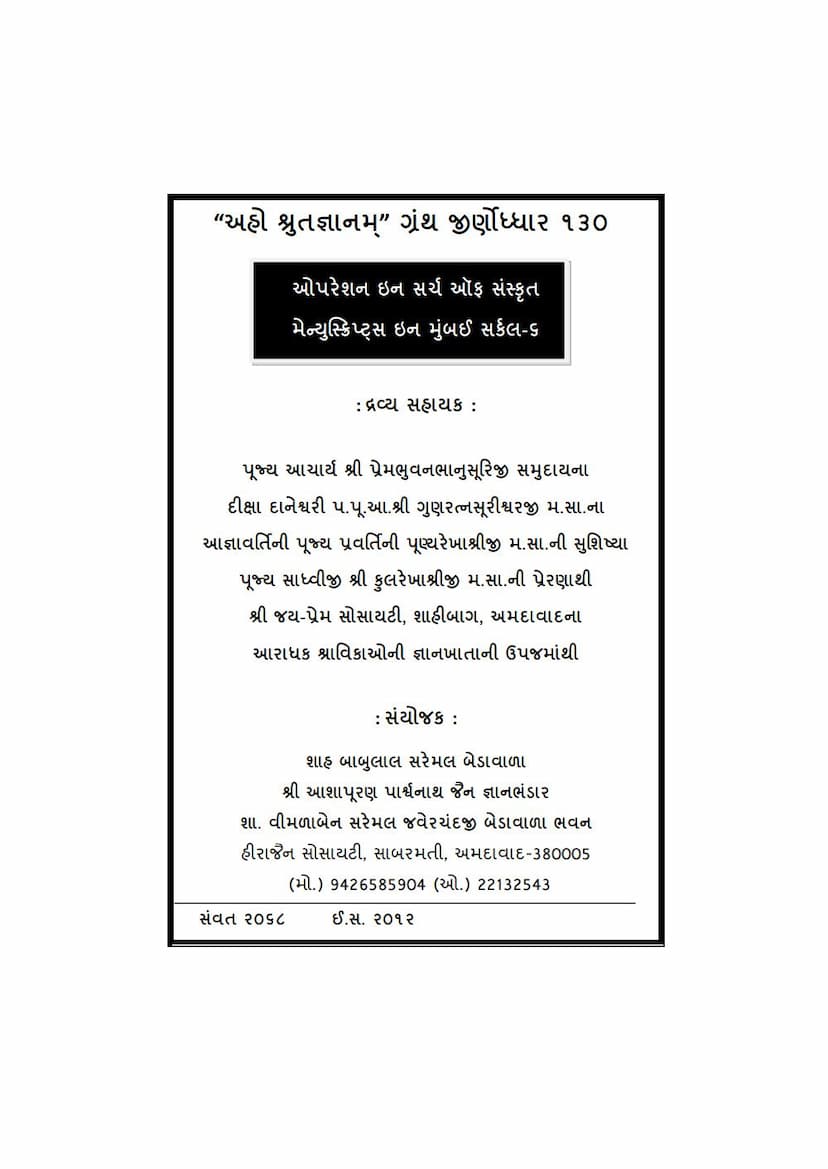Operation In Search Of Sanskrit Manuscripts In Mumbai Circle 6
Added to library: September 2, 2025

Summary
This document is a detailed catalog of Sanskrit manuscripts, primarily Jain texts, collected or examined as part of an operation to find Sanskrit manuscripts in the Bombay Circle. The catalog is compiled as part of the "Sixth Report of Operations in Search of Sanskrit MSS. in the Bombay Circle. April 1895-March 1898." by P. Peterson, published by the Royal Asiatic Society.
Here's a comprehensive summary of its key aspects:
Title and Context: The title itself, "Operation In Search of Sanskrit Manuscripts in Mumbai Circle 6," indicates a systematic effort to locate and document Sanskrit manuscripts within a specific geographical region (Bombay Circle, understood as modern Mumbai and its surrounding areas). This is the sixth report in a series, suggesting a long-term project by the Royal Asiatic Society.
Purpose and Methodology: The core purpose of this undertaking was to identify, catalog, and preserve ancient Sanskrit and Jain literature. The methodology involved:
- Searching and Acquisition: Manuscripts were actively sought and purchased for the government.
- Cataloging: Each manuscript is listed with details such as its number, title, author, number of pages, number of lines per page, approximate number of characters, the Sanskrit year (Samvat) of its creation, and notes on its condition (e.g., complete, incomplete, damaged).
- Extracts and Appendices: The report includes appendices containing extracts from some of the purchased manuscripts, providing a glimpse into their content. A list of all purchased manuscripts is also provided.
- Author Index: A significant portion of the document is dedicated to an "Index of Authors," which provides biographical and bibliographical information about the various authors of these manuscripts. This index is crucial for understanding the scholarly context and lineage of Jain and Sanskrit literature.
Content and Scope: The catalog covers a vast array of manuscripts, spanning various genres of Sanskrit and Jain literature. The listed manuscripts include:
- Jain Canonical Texts: Sutras like the Nandi Sutra, Uttaradhyayana Sutra, and their commentaries (Churni, Vritti, Tippani).
- Philosophical and Logical Treatises: Works on Tattvartha, Nyaya, Vedanta, and various philosophical schools are prominently featured. Authors like Umasvati, Samantabhadra, Akalanka, Vidyananda, and various Jain Acharyas are frequently mentioned.
- Grammar: Significant works on Sanskrit and Prakrit grammar are listed, including commentaries on Hemachandra's grammar.
- Architecture and Art: Texts related to Shilpa Shastra, Vastu Vidya, and temple architecture are included, indicating the diverse range of knowledge preserved.
- Astrology and Astronomy: Works on Jyotisha are also present.
- Literature and Poetry: Plays, epics, and devotional literature are cataloged.
- Commentaries and Sub-commentaries: Many entries refer to commentaries (Vritti, Bhashya, Tika, Avachuri) on earlier works, showcasing the tradition of scholarly elaboration.
- Historical and Epigraphic Records: Several entries mention "Jain Lekh Sangrah" (Collection of Jain Inscriptions) and similar titles, highlighting the inclusion of epigraphic material.
- Sanskrit and Prakrit Works: While the primary focus is Sanskrit, Prakrit works are also listed, reflecting the close relationship between these languages in Jain traditions.
- Specific Jain Sects: The catalog implicitly or explicitly references works associated with different Jain traditions (e.g., Svetambara).
Key Figures and Institutions:
- P. Peterson: The author and primary investigator of this operation.
- Royal Asiatic Society: The publishing body, indicating the academic and institutional backing of the project.
- Shri Ashapurana Parshvanath Jain Gyan Bhandar: This institution in Ahmedabad, Gujarat, appears to be a significant contributor or collaborator, with Shah Babulal Sarimal and Shah Vimalaben Sarimal Javerchandji Bedavala listed as organizers for the "Aho Shrutgyanam Granth Jirnodhdhar" (Restoration of the book "Aho Shrutgyanam"). This indicates a focus on preserving and digitizing (scanning for DVD) ancient Jain texts.
- Various Jain Acharyas and Scholars: The author index lists numerous influential Jain scholars and Acharyas, such as Vikramasuri, Jinasagar, Hemachandrasuri, Gunaratnasuri, Yashovijaya, and many others, highlighting the rich intellectual heritage of Jainism.
Significance: This report serves as a vital resource for:
- Scholars of Jainism and Sanskrit Literature: It provides a detailed inventory of important manuscripts, allowing researchers to identify texts for further study.
- Preservation Efforts: The systematic cataloging and the mention of scanning for DVDs highlight efforts towards the preservation of these invaluable literary works.
- Historical Research: The inclusion of epigraphic and historical records contributes to understanding the history and spread of Jainism.
- Linguistic Studies: The catalog offers a wealth of information for those studying the evolution of Sanskrit and Prakrit languages.
In essence, this document is a meticulous record of a significant scholarly endeavor to survey and preserve the vast literary heritage of Jainism and Sanskrit literature in the Bombay region during the late 19th century, with a notable emphasis on restoration and digitization efforts by modern Jain institutions.